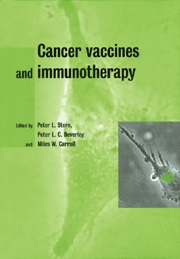Book contents
- Frontmatter
- Contents
- List of contributors
- 1 Immunity and cancer
- 2 Immunotherapy of bladder cancer
- 3 Poxviruses as vectors for cancer immunotherapy
- 4 Vaccinia-based human papillomavirus vaccines in cervical cancer
- 5 Vaccine delivery and immunosuppression in cervical cancer
- 6 Vaccines for colon cancer
- 7 MUC1 vaccines and breast cancer
- 8 Anti-idiotypic vaccination
- 9 Immunotherapy and vaccination against Epstein–Barr virus-associated cancer
- 10 Serologically identified tumour antigens as cancer vaccines
- 11 CTL-defined cancer vaccines in melanoma and other epithelial cancers
- 12 DNA vaccines against B-cell tumours
- 13 Dendritic cell approaches to immunotherapy
- 14 Overview
- 15 Recent developments
- Index
14 - Overview
Published online by Cambridge University Press: 06 January 2010
- Frontmatter
- Contents
- List of contributors
- 1 Immunity and cancer
- 2 Immunotherapy of bladder cancer
- 3 Poxviruses as vectors for cancer immunotherapy
- 4 Vaccinia-based human papillomavirus vaccines in cervical cancer
- 5 Vaccine delivery and immunosuppression in cervical cancer
- 6 Vaccines for colon cancer
- 7 MUC1 vaccines and breast cancer
- 8 Anti-idiotypic vaccination
- 9 Immunotherapy and vaccination against Epstein–Barr virus-associated cancer
- 10 Serologically identified tumour antigens as cancer vaccines
- 11 CTL-defined cancer vaccines in melanoma and other epithelial cancers
- 12 DNA vaccines against B-cell tumours
- 13 Dendritic cell approaches to immunotherapy
- 14 Overview
- 15 Recent developments
- Index
Summary
Introduction
The volume has covered aspects of the development of therapeutic cancer vaccine strategies against a variety of molecular targets and diseases with a strong bias to the generation of specific cell-mediated (CTL) responses. This brief overview will consider some common lessons with respect to: (1) target molecules; (2) delivery systems; and (3) evaluation methodology relevant to success of immunotherapy for cancer. A summary of the rationale, optimism, limitations and further keys for development for the various cancer vaccine approaches outlined in this volume is given in Table 14.1.
Target molecules
Viral targets
When there is an established viral aetiology for particular malignancies such as HPV with cancer of the uterine cervix or EBV with nasopharyngeal carcinoma, virally encoded tumour-associated molecules offer exogenous cancer vaccine targets where there is unlikely to be immunological tolerance at the immune repertoire level. However, prevention will always be better than cure, so immunization to reduce infection is likely to be more efficacious and cost-effective than immuno-therapeutic approaches. This is clearly shown by the example of the association of hepatitis B virus with hepatocellular carcinoma, where classical prophylactic vaccination programmes have dramatically influenced the incidence of the cancer in at risk populations. A similar strategy for the high risk papillomaviruses associated with cervical neoplasia is also planned.
Overall, the implementation of worldwide immunization against viruses such as HPV, where the malignant disease is a late complication of the viral infection, may be difficult.
- Type
- Chapter
- Information
- Cancer Vaccines and Immunotherapy , pp. 256 - 267Publisher: Cambridge University PressPrint publication year: 2000



